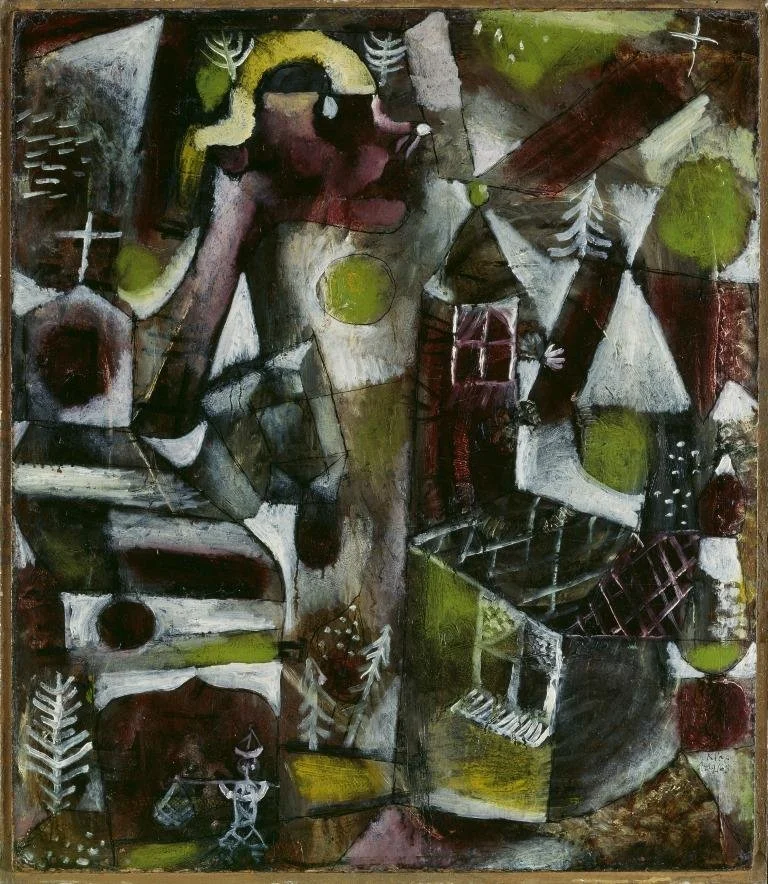Vorwort
Abb. 1
Paul Klee
Sumpflegende, 1919, 163
Ölfarbe und Feder auf Karton, 47 x 40,8 cm
Städtische Galerie im Lenbachhaus und Kunstbau München, Gabriele Münter- und Johannes Eichner-Stiftung, München, Vergleich 2017 mit den Erb*innen der früheren Eigentümerin Sophie Lissitzky-Küppers, mit grosszügiger finanzieller Unterstützung der Kulturstiftung der Länder und der Ernst von Siemens Kunststiftung
© Städtische Galerie im Lenbachhaus und Kunstbau München
Anlässlich der 10. Ausgabe der Zwitscher-Maschine wurde ein Gespräch zur Frage »Was wird heute über Paul Klee gezwitschert?« geführt. Eine erfreuliche, konkrete Antwort findet sich in dieser 11. Ausgabe: Interdisziplinäre vielfältige Forschungsthemen (Kinderpsychologie, Architektur- und Musikgeschichte, Provenienzforschung u. a.) und eine vertiefte, kritisch-historische Analyse der Werke Klees in einem erweiterten historischen Kontext.
Die Studie von Barbara Bechtler beleuchtet die Kinderzeichnung als Inspirationsquelle für Klees künstlerisches Schaffen aus entwicklungspsychologischer Sicht. Der Aufsatz von Osamu Okuda, der zuvor in italienischer Sprache erschienen ist, kann jetzt in der deutschen Originalfassung gelesen werden. Er geht der Frage nach, wie die »ursprünglichen Quellen« von Klees Kunst im fliessenden (Zeit-)Fluss unterschiedlich gestaltet sind. Marie Kakinuma setzt in dem neuen Beitrag »Gespaltene« Werke bei Paul Klee ihre produktionsgeschichtliche, materialorientierte Forschung fort. Dabei lässt sie erstmals die Geschichte der späteren Trennung der ursprünglich doppelseitigen Bilder Sumpflegende, 1919, 163 (ABB. 1) und Ohne Titel (ABB. 2) nachvollziehen. Giacomo Ontano seinerseits rekonstruiert und analysiert die von dem italienischen Architekten Carlo Scarpa gestaltete Klee-Ausstellung auf der Biennale von Venedig 1948, um die »langanhaltende Inspirationsquelle« der Auseinandersetzung Scarpas mit Klees Werken zu verdeutlichen. Die musikalisch-künstlerische Freundschaft vom heute zu Unrecht vergessenen, bedeutenden Wiener Pianisten Gottfried Galston und Paul Klee, selber ausgezeichneter Geiger, wird durch Florence Webers Magisterarbeit (Universität Bern) über Galstons Aktivitäten als Pädagoge und Konzertpianist klarere Konturen annehmen. Wir veröffentlichen deshalb die gesamte Arbeit als PDF-Beilage. Anhand von Innenaufnahmen der privaten Kunstsammlung von Maja Sacher-Stehlin versucht Walther Fuchs, die Sammlungs- und Provenienzgeschichte der Klee-Gemälde anhand von teilweise unveröffentlichtem Quellenmaterial zu erforschen und ein Bild der Kunstsammlerin zu zeichnen. Michael Baumgartner skizziert die Spuren der Begegnung zwischen Max Huggler, dem Direktor der Kunsthalle Bern zwischen 1931 und 1943, und Paul Klee.
In den nächsten Nummern der Zwitscher-Maschine werden wir nach und nach die neu entdeckten Werke von Klee veröffentlichen, die nicht im neun Bände umfassenden Catalogue raisonné enthalten sind. Als Vorschau zeigen wir ein Beispiel in Form eines Tweets. Schliesslich freuen wir uns sehr, dass Katrin Keller, Marianne Keller Tschirren und Kai-Inga Dost, vom Zentrum Paul Klee, das Redaktionsteam verstärken.
Die Herausgeber:
Fabienne Eggelhöfer, Zentrum Paul Klee, Bern
Walther Fuchs, Digiboo Verlag, Küsnacht
Osamu Okuda, Zentrum Paul Klee, Bern
Editorial
Fig. 2
Paul Klee
Untitled
Oil paint on canvas, 47 x 40.5 cm
Location unknown
Image credit: Zentrum Paul Klee, Bern, archive
On the occasion of the 10th edition of the Zwitscher-Maschine, a conversation was conducted on the question “What is being twittered about Paul Klee today?” A gratifying, concrete answer can be found in this 11th edition: interdisciplinary diverse research topics (child psychology, architectural and music history, provenance research, and others) and an in-depth, critical analysis of Klee's works in a broader historical context.
The study by Barbara Bechtler deals from the perspective of developmental psychology with children's drawing as a source of inspiration for Klee's artistic work. The essay by Osamu Okuda, previously published in Italian, can now be read in the original German version. It explores the question of how the “primordial sources” of Klee's art are shaped differently in the subsequent periods. In the new contribution “Gespaltene” Werke bei Paul Klee, Marie Kakinuma continues her production-historical, material-oriented research. In doing so, she traces for the first time the history of the posthumous separation of the originally double-sided works Swamp Legend, 1919, 163 (FIG. 1) and Untitled (FIG. 2). For his part, Giacomo Ontano reconstructs and analyzes the Klee exhibition at the 1948 Venice Biennale, designed by the Italian architect Carlo Scarpa, in order to clarify the “long-lasting source of inspiration” of Scarpa's engagement with Klee's works. The musical-artistic friendship between the nowadays unjustly forgotten, important Viennese pianist Gottfried Galston and Paul Klee, himself an excellent violinist, will take on clearer contours through Florence Weber's master's thesis (University of Bern) on Galston's activities as a pedagogue and concert pianist. We are therefore publishing the entire thesis as a PDF supplement. Using interior photographs of Maja Sacher-Stehlin's private art collection, Walther Fuchs attempts to explore the collection and provenance history of the Klee paintings based on partially unpublished source material and to draw a picture of the art collector. Michael Baumgartner sketches the traces of the encounter between Max Huggler, the director of the Kunsthalle Bern between 1931 and 1943, and Paul Klee.
In the next issues of the Zwitscher-Maschine we will gradually publish the newly discovered works by Klee that are not included in the nine-volume Catalogue raisonné. As a preview, we show an example in the form of a tweet.
Finally, we are very pleased that Katrin Keller, Marianne Keller Tschirren and Kai-Inga Dost, from the Zentrum Paul Klee, are joining the editorial team.
The editors:
Fabienne Eggelhöfer, Zentrum Paul Klee, Bern
Walther Fuchs, Digiboo Publishers, Küsnacht
Osamu Okuda, Zentrum Paul Klee, Bern
